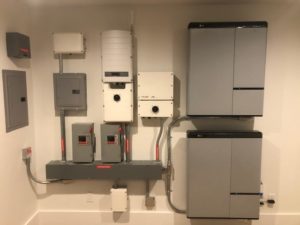Solar energy battery storage has become an extremely hot topic, particularly in the State of California. Before the rampant wildfires the state experienced over the past several years, most homeowners would install a “grid-tied” solar system to save money. However, due to the electrical utility blackouts energy storage has become more and more popular for homeowners who want to ensure that they have electricity even when the electric grid is not functioning. This is accomplished by pairing a solar photovoltaic (PV) system with a battery energy storage system (BESS).
Solar batteries work by capturing energy produced by your solar panels and storing it for future use. When you install a solar battery as part of your home solar system, you can store excess solar electricity at your home instead of sending it back to the grid. If your solar panels are producing more electricity than you need, the excess energy goes towards charging the battery. Later, when your solar panels are not producing electricity (on cloudy/rainy days or at night), you can draw down the energy you stored earlier in your battery. You will only send electricity back to the grid when your battery is fully charged, and you will only draw electricity from the grid when your battery is depleted.
While the main purpose of solar batteries in home solar applications is to provide energy resiliency, home solar batteries can also provide for some financial savings with electric utility time of use billing. As millions of Californians have gone solar utilities now default residential customers with a home solar system to time of use billing, which means that instead of getting billed by how much electricity the home uses (and paying a higher price for using more energy), the homeowner gets billed by how much electricity they use at various times of the day. Electric utilities experience the most stress on the grid in the late afternoon and early evening when solar production wanes off. For this reason, they charge the highest prices of the day during this “peak” period. Without a home solar battery, homeowners run the risk of pulling energy from the grid at the most expensive time of day. With a home solar battery, energy that was stored from earlier in the day can be deployed in the home to avoid these excessive electricity charges.
The state of California is incentivizing the adoption of home solar batteries with a one-time cash rebate based upon the size of the solar battery system. The Self Generation Incentive Program (SGIP) works on a first come first serve basis and checks typically take about a year to process from the time of utility interconnection. Adding a solar battery to your home solar system will typically add about two years of time to the payback period to recoup your investment. If you are financing your purchase, it will reduce the savings received vs a regular grid tied home solar system, but you can rest easy at night knowing that even in the event of a natural disaster or utility forced grid outage your critical loads will keep running. Common critical loads that we see backed up are for home offices, kitchen appliances, security systems, audio visual systems, lighting, bedrooms, and even wine cellars! Critical loads that are too big to back up include electric vehicle charging outlets, pool pumps, and air conditioning.
A Manhattan Beach, CA Home Solar Battery System I consulted on
Want to see how much money you can save with a residential solar panel and solar battery system? Get your turnkey solar panel and solar battery proposal with ROI and financing options by uploading your most recent electric bill (all pages), a picture of the electrical panel outside your home, and a picture of your roof today HERE.


